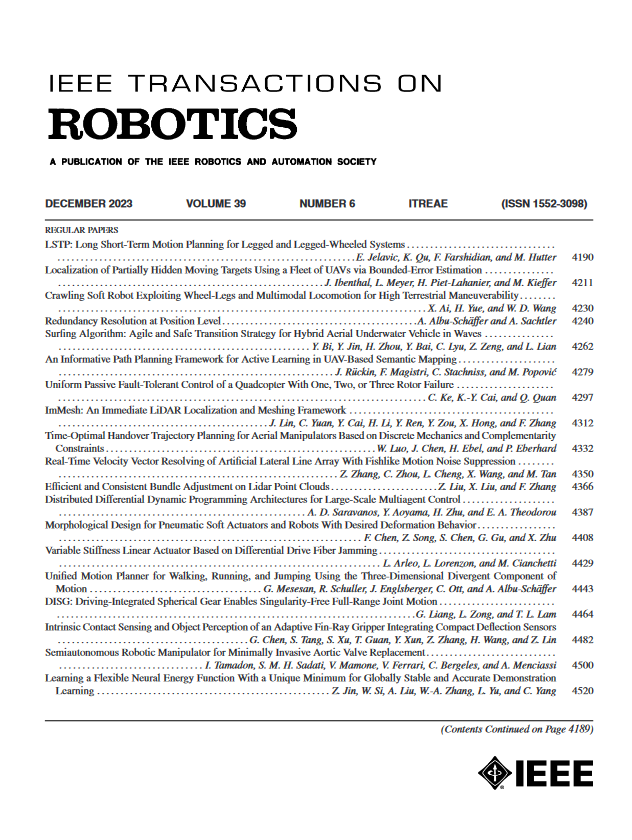基于可见度的追逐-入侵近似方法
IF 9.4
1区 计算机科学
Q1 ROBOTICS
引用次数: 0
摘要
据我们所知,本研究中涉及的基于可见度的点代理和多边形障碍物的追逐-规避问题的精确解还不为人所知。鉴于上述情况,我们在本研究中提出了针对这种追逐-逃避博弈的近似算法,但这种算法是可行的,并具有其他理想的特性。我们的新方法结合了基于采样的渐近最优运动规划(更具体地说,最优概率路线图)和动态编程的值迭代。此外,我们的方法还能在存在奇异曲面的情况下为逃逸者找到解决方案,而这是之前的研究无法找到的。在这项工作中,我们获得了两个主要的理论结果。首先,我们证明了所提出的离散表述是正确的(该方法能获得给定配置空间离散化的解决方案)。随后,结合随机图结果、贝尔曼最优性原理和极限,我们证明了当样本数趋于无穷大时,我们的近似离散公式会变成与汉密尔顿-雅各比-伊萨克方程相对应的连续公式。这就产生了一种可行的方法,随着样本数量的增加,其近似性也会提高。在二维和三维环境中对简单和多重连接的障碍物进行的模拟实验体现了新方法的结果,并显示了与之前工作相比的优势。本文章由计算机程序翻译,如有差异,请以英文原文为准。
Approximate Methods for Visibility-Based Pursuit–Evasion
To the best of our knowledge, an exact solution to the visibility-based pursuit–evasion problem with point agents and polygonal obstacles addressed in this work is not known. Given the above, in this work, we present approximate algorithms, but feasible and with other desirable properties, for such a pursuit–evasion game. Our new method combines asymptotically optimal motion planning based on sampling (more specifically, optimal probabilistic roadmaps) and the value iteration of dynamic programming. In addition, our formulation finds solutions for the evader when there are singular surfaces, which previous work could not find. In this work, we obtain two main theoretical results. We first prove that the proposed discrete formulation is correct (that the method obtains the solution for the discretization of the given configuration space). Subsequently, combining random graph results, Bellman's optimality principle, and limits, it is proved that, as the number of samples tends to infinity, our approximate discrete formulation becomes the continuous formulation corresponding to the Hamilton–Jacobi–Isaacs equation. This results in a feasible method that improves its approximation as the number of samples increases. Simulation experiments in 2-D and 3-D environments with obstacles that are simply and multiplicattively connected exemplify the results of the new method and show the advantages over previous work.
求助全文
通过发布文献求助,成功后即可免费获取论文全文。
去求助
来源期刊

IEEE Transactions on Robotics
工程技术-机器人学
CiteScore
14.90
自引率
5.10%
发文量
259
审稿时长
6.0 months
期刊介绍:
The IEEE Transactions on Robotics (T-RO) is dedicated to publishing fundamental papers covering all facets of robotics, drawing on interdisciplinary approaches from computer science, control systems, electrical engineering, mathematics, mechanical engineering, and beyond. From industrial applications to service and personal assistants, surgical operations to space, underwater, and remote exploration, robots and intelligent machines play pivotal roles across various domains, including entertainment, safety, search and rescue, military applications, agriculture, and intelligent vehicles.
Special emphasis is placed on intelligent machines and systems designed for unstructured environments, where a significant portion of the environment remains unknown and beyond direct sensing or control.
 求助内容:
求助内容: 应助结果提醒方式:
应助结果提醒方式:


